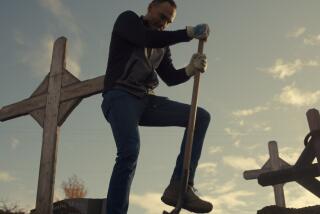Winnipeg Takes Different Tacks With Indian Gangs
- Share via
WINNIPEG, Manitoba — It’s a side of Canada most Canadians don’t want to see: gritty Winnipeg streets where poverty and racism produce a stream of embittered recruits for ever-bolder Indian street gangs.
The gang names aren’t subtle: The Indian Posse and Manitoba Warriors are the biggest. City police have formed a special anti-gang unit; officials battle to keep the gangs out of schools; prison guards blame gang members for a savage riot in April at Manitoba’s biggest prison.
Though the anti-gang squad takes a get-tough approach, recording 600 arrests since it started a year ago, the unit’s commander says he understands why some youths veer toward the gangs.
“You’ve got nothing else to look up to or look forward to, no hopes of job prospects,” Inspector Al Brolly said. “Your role models are low-level criminals.”
Jeremy Montour, a crew-cut 16-year-old with a ready grin and long arrest record, shares Brolly’s analysis.
“In a gang, you’re somebody,” said Montour, who recently was kicked out of his high school after breaking a rival’s nose. He now is studying, off and on, at an Indian community center in a program designed to give one more chance to youths who have dropped out or been expelled from regular schools.
Montour and his friends, sharing their stories around a classroom table, said Winnipeg abounds in anti-Indian racism, sometimes subtle, sometimes not.
“You can feel it, you can hear it--’Look at that dirty Indian,’ ” he said.
Winnipeg has the biggest concentration of Indians of any city in Canada--about 10% of the 600,000 population. Most live in impoverished neighborhoods, where many of the small wooden homes are dilapidated and unemployment is rampant.
In the neighborhoods around Children of the Earth High School, founded five years ago as the city’s first Indian-only public school, three-quarters of the families have no breadwinner and 80% live below the poverty line, school officials say. The suicide rate for Indian youths is 10 times that for white youths.
In Winnipeg’s more prosperous neighborhoods, the problems seem distant. Relatively few Indians are hired for jobs there, and Michael Paluk, a white legal-aid lawyer, says he has been in restaurants that make clear their distaste of Indian customers.
Brolly says the gang problem festered for several years, but grew worse in 1994 when muggings increased sharply and gangs brazenly marched arm-in-arm through upscale shopping malls.
Police struck back with 165 arrests in three months, and have taken a hard-line approach ever since.
“Our policy is zero tolerance,” Brolly said. “If someone wants to act tough, they get treated tough.”
He said police have identified about 300 hard-core gang members, ranging in age from 12 on up. Hundreds more youths are believed to be loosely affiliated with the gangs, if only to avoid the isolation and violence sometimes directed at those who refuse to join.
“Kids feel they either have to belong to a gang or they just can’t make it out there,” said Rhonda McCorriston, who runs the Songide’ewin Program, where Montour and about 100 other teenagers are trying to salvage an education.
She insists that her students abandon their gang lingo in the classroom, and tries to break their habit of drawing gang symbols all over the place--the letters “IP” for the Indian Posse, a dollar sign for the Deuce gang.
McCorriston, of mixed white and Indian descent, says the courts, schools and social agencies all deserve some blame for the gang phenomenon. She says many of the street kids have suffered sustained physical or sexual abuse at home.
“One of my girls’ parents used to hold her down and pour alcohol down her throat,” said McCorriston, herself a victim of abuse from her father and her ex-husband.
The gangs fight each other, but also engage in robberies, car theft and drug dealing. Their scope is widening: Police chiefs in the neighboring province of Saskatchewan complain about incursions by the Winnipeg gangs, and the Manitoba Warriors dispatched gunmen recently to reinforce a dissident faction at a rural reserve far north of Winnipeg.
Brolly says the gangs have no serious political agenda.
“Their political statement is being in a gang,” he said.
The gangs are loosely structured, police say. The leaders are mostly in their 20s or late teens, and the most active lawbreakers in their mid teens, backed by youngsters of 11 or 12 known as “wannabes.”
Initiation rites vary. Montour says he was pummeled by five gang veterans when he joined at age 13.
“I was kind of stiff afterwards, that’s all,” he said.
At Headingley Prison, guards reported that Indian Posse members would force newly arriving inmates to join, initiating them by giving them tattoos on their hands or backs.
Members of the Posse and the Warriors were blamed for the horrific violence at Headingley during a 24-hour riot in late April. Rioters severely beat guards and fellow convicts, cutting fingers off at least three prisoners.
More than 80% of Headingley’s inmates were Indians, many of them first incarcerated in youth centers at 12 or 13.
Doug Skoog, a University of Winnipeg criminologist, said the riots were predictable.
“We’ve kind of created this ghettoized population in the inner city,” he said. “These kids aren’t stupid. They know the world doesn’t hold much promise for them. So they are willing to take risks--big risks.”
Trying to restore a sense of hope is one of the missions at Children of the Earth High School, a bright, airy building serving 240 Indian students. Most are from Winnipeg; a few come from rural reserves with no high schools.
Principal Mary Courchene said the school’s philosophy is based on Indian traditions, with a central theme of seeking to govern oneself emotionally, physically and spiritually. Students study Indian history and culture; there is mandatory instruction in either Cree or Ojibwa.
“Even though we have gang members here, they know when they enter the doors that’s put aside,” Courchene said. “They know this school is different.”
Like many middle-aged Indians, Courchene suffered through an often patronizing and abusive educational system when she was young.
“Having been through a system that took away our pride and dignity, we have to undo all that,” she said. “In a way, this kind of renaissance is easier in the city than on the reserves. Students here are starved for their heritage.”
At Winnipeg’s regular schools, violence-prevention and anti-gang programs have been in place for up to seven years.
Staff are trained to recognize gang symbols and paraphernalia and urged to photograph suspicious loiterers. Students face immediate expulsion if caught on campus with a weapon.
McCorriston said job prospects for Indian youths in Winnipeg are so bleak that they face a stark choice: “You can live on the street, or you can get a university education.”
Even some of her most street-hardened students nurture ambitious dreams.
James Hobson, a wiry 14-year-old who joined the Indian Posse at 12, has been arrested for car theft and once threw a chair at a teacher. But he says he’d like to be an archeologist.
Tara Sterling, 16, has bounced through seven foster homes and amassed a varied arrest record for assault, drugs and loitering. She lives at a Salvation Army center, is trying to quit her gang, and wants to study law.
“There needs to be good lawyers, someone who knows what they’re doing,” she said. “I know, because my lawyers were really bad.”
More to Read
Sign up for Essential California
The most important California stories and recommendations in your inbox every morning.
You may occasionally receive promotional content from the Los Angeles Times.










